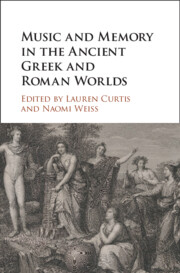Book contents
- Music and Memory in the Ancient Greek and Roman Worlds
- Music and Memory in the Ancient Greek and Roman Worlds
- Copyright page
- Contents
- Figures
- Contributors
- Acknowledgments
- Note on Texts and Abbreviations
- Part I Approaching Music and Memory
- Part II Music, Body, and Textual Archives
- Part III Technologies of Musical Memory
- Chapter 5 Do Alexandrians Dream of Electric Sound?
- Chapter 6 Teichoacoustics, or the Wall as Sonic Medium in Antiquity
- Part IV Audience, Music, and Repertoire
- Part V Music and Memorialization
- Bibliography
- General Index
- Index Locorum
Chapter 6 - Teichoacoustics, or the Wall as Sonic Medium in Antiquity
from Part III - Technologies of Musical Memory
Published online by Cambridge University Press: 14 October 2021
- Music and Memory in the Ancient Greek and Roman Worlds
- Music and Memory in the Ancient Greek and Roman Worlds
- Copyright page
- Contents
- Figures
- Contributors
- Acknowledgments
- Note on Texts and Abbreviations
- Part I Approaching Music and Memory
- Part II Music, Body, and Textual Archives
- Part III Technologies of Musical Memory
- Chapter 5 Do Alexandrians Dream of Electric Sound?
- Chapter 6 Teichoacoustics, or the Wall as Sonic Medium in Antiquity
- Part IV Audience, Music, and Repertoire
- Part V Music and Memorialization
- Bibliography
- General Index
- Index Locorum
Summary
A wall is a sonic medium. It gathers, reflects, amplifies (or sometimes attenuates), and otherwise processes sound; it thereby creates strata of sensory memory and history. Rethinking the notion of teichoscopy (the use of walls to enhance vision), I propose an analogous concept of teichoacoustics in the Greek and Roman worlds –using walls as a technical means of sounding and hearing; that is, transmitting and receiving auditory sensation. I focus on four cities and their walls: Babylon in the tale of Pyramus and Thisbe (via Ovid, Shakespeare, and the Beatles); Troy during the Trojan War, especially Helen’s visit to the city walls in Iliad 3; Thebes, from the creation of its walls through music to its depiction in tragedy; and finally Delphi and the musical inscriptions on the external walls of buildings there. While the particular media functions of sound vary at each of these different sets of walls, these examples demonstrate a number of productive relations between sound and walls, and suggest possibilities for a practice of listening to architecture – both figuratively and literally – as a way of excavating cultural memory in and about antiquity.
- Type
- Chapter
- Information
- Music and Memory in the Ancient Greek and Roman Worlds , pp. 148 - 172Publisher: Cambridge University PressPrint publication year: 2021



